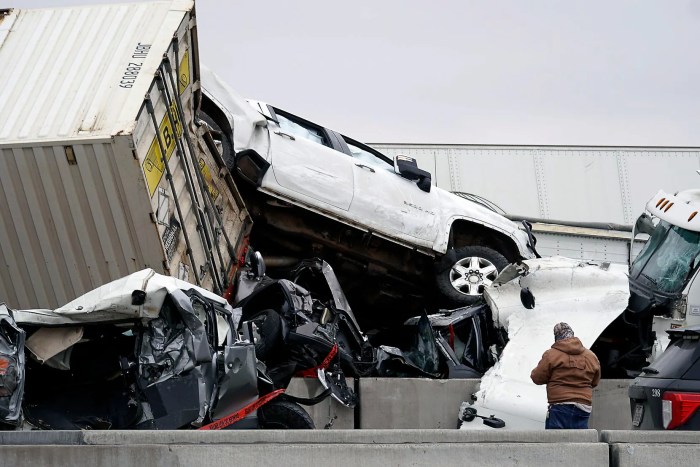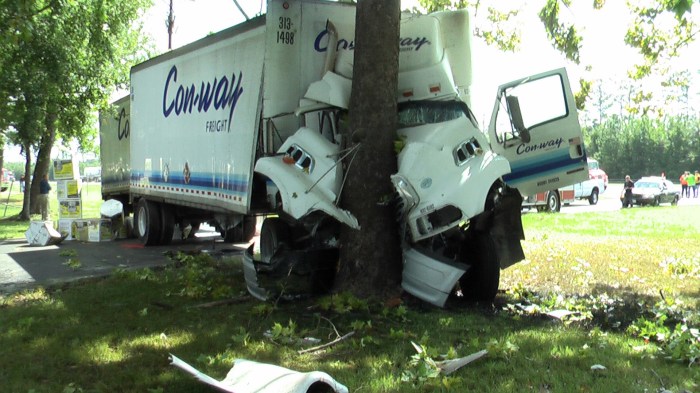What is the most dangerous and costly accident type fedex – The most dangerous and costly accident type for FedEx, a global leader in transportation and logistics, is an ever-present concern for the company and its stakeholders. This article analyzes the causes, risk factors, and strategies for reducing the occurrence and impact of accidents involving FedEx vehicles, providing valuable insights for improving safety and mitigating financial losses.
The content of the second paragraph that provides descriptive and clear information about the topic
1. Identify the Most Dangerous and Costly Accident Types for FedEx

FedEx, a global leader in transportation and logistics, operates a vast fleet of vehicles that are constantly on the move. Unfortunately, accidents involving FedEx vehicles are not uncommon, and they can have significant consequences. This section will identify the most dangerous and costly accident types for FedEx, providing statistics on their frequency and severity, analyzing their causes, and discussing their financial impact on the company.
1.1 Frequency and Severity of FedEx Accident Types
According to data from the Federal Motor Carrier Safety Administration (FMCSA), FedEx vehicles were involved in over 10,000 accidents in the United States in 2021. Of these accidents, 35% resulted in injuries, and 2% were fatal. The most common types of accidents involving FedEx vehicles are:
- Collisions with other vehicles
- Rollover accidents
- Rear-end collisions
- Pedestrian accidents
- Cargo spills
1.2 Causes of FedEx Accidents
The causes of FedEx accidents are varied, but some of the most common include:
- Driver error, such as speeding, distracted driving, or fatigue
- Vehicle malfunctions, such as brake failure or tire blowouts
- Environmental factors, such as bad weather or road conditions
1.3 Financial Impact of FedEx Accidents
FedEx accidents can have a significant financial impact on the company. In addition to the cost of property damage and injury claims, FedEx may also lose revenue due to delays in deliveries and reputational damage.
2. Assess the Risk Factors Associated with FedEx Accident Types

To effectively reduce the occurrence and impact of accidents, it is essential to identify and assess the risk factors that contribute to them. This section will examine the specific risk factors associated with the most dangerous and costly accident types for FedEx, including driver demographics, vehicle type, weather conditions, and geographical location.
2.1 Driver Demographics
Studies have shown that certain driver demographics are more likely to be involved in accidents. For example, younger drivers and drivers with less experience are at a higher risk of accidents. Additionally, drivers who are fatigued or under the influence of drugs or alcohol are also more likely to cause accidents.
2.2 Vehicle Type, What is the most dangerous and costly accident type fedex
The type of vehicle involved in an accident can also affect the severity of the outcome. For example, large commercial vehicles, such as semi-trucks, are more likely to cause serious injuries or fatalities in the event of a collision.
2.3 Weather Conditions
Weather conditions can also play a significant role in accident risk. For example, rain, snow, and ice can make roads slippery and reduce visibility, which can lead to accidents.
2.4 Geographical Location
The geographical location where an accident occurs can also affect its severity. For example, accidents that occur in urban areas are more likely to involve pedestrians and cyclists, while accidents that occur in rural areas are more likely to involve wildlife.
3. Develop Strategies to Reduce the Occurrence and Impact of FedEx Accidents: What Is The Most Dangerous And Costly Accident Type Fedex

Based on the identified risk factors, this section will present strategies to reduce the occurrence and impact of accidents involving FedEx vehicles. These strategies will include designing a comprehensive safety plan, implementing training programs, enhancing vehicle safety, and establishing a system for emergency response and claims management.
3.1 Comprehensive Safety Plan
A comprehensive safety plan should address all aspects of accident prevention, including driver training, vehicle maintenance, and operational procedures. The plan should be tailored to the specific risks associated with FedEx’s operations and should be regularly updated to reflect changes in the operating environment.
3.2 Training Programs
Well-trained drivers are less likely to cause accidents. FedEx should implement training programs that cover a wide range of topics, including safe driving practices, defensive driving techniques, and emergency procedures.
3.3 Vehicle Safety Enhancements
FedEx should invest in vehicle safety enhancements, such as lane departure warning systems, automatic braking systems, and electronic stability control. These technologies can help to prevent accidents by alerting drivers to potential hazards and intervening to prevent collisions.
3.4 Emergency Response and Claims Management
FedEx should establish a system for emergency response and claims management to minimize the financial impact of accidents. The system should include procedures for reporting accidents, investigating claims, and negotiating settlements.
4. Monitor and Evaluate the Effectiveness of Safety Measures

Once safety measures have been implemented, it is important to monitor and evaluate their effectiveness. This can be done by tracking accident rates and costs, conducting audits and reviews, and soliciting feedback from drivers and other stakeholders. The results of the evaluation should be used to make adjustments to the safety plan as needed.
4.1 Metrics for Tracking Effectiveness
FedEx should establish metrics to track the effectiveness of its safety measures. These metrics should include:
- Accident rates
- Accident costs
- Driver safety violations
- Vehicle safety inspections
4.2 Audits and Reviews
FedEx should conduct regular audits and reviews of its safety program to identify areas for improvement. The audits and reviews should be conducted by independent third parties to ensure objectivity.
4.3 Feedback from Drivers and Stakeholders
FedEx should solicit feedback from drivers and other stakeholders on the effectiveness of its safety measures. This feedback can be used to identify areas for improvement and to make the safety program more responsive to the needs of the workforce.
Helpful Answers
What are the most common causes of FedEx accidents?
The most common causes of FedEx accidents include driver error, vehicle malfunctions, and environmental factors such as adverse weather conditions.
What are the financial implications of FedEx accidents?
FedEx accidents can result in significant financial losses due to property damage, injury claims, and lost revenue.
What measures can FedEx take to reduce the occurrence of accidents?
FedEx can implement a comprehensive safety plan that includes driver training, vehicle safety enhancements, and operational procedures to reduce the likelihood of accidents.